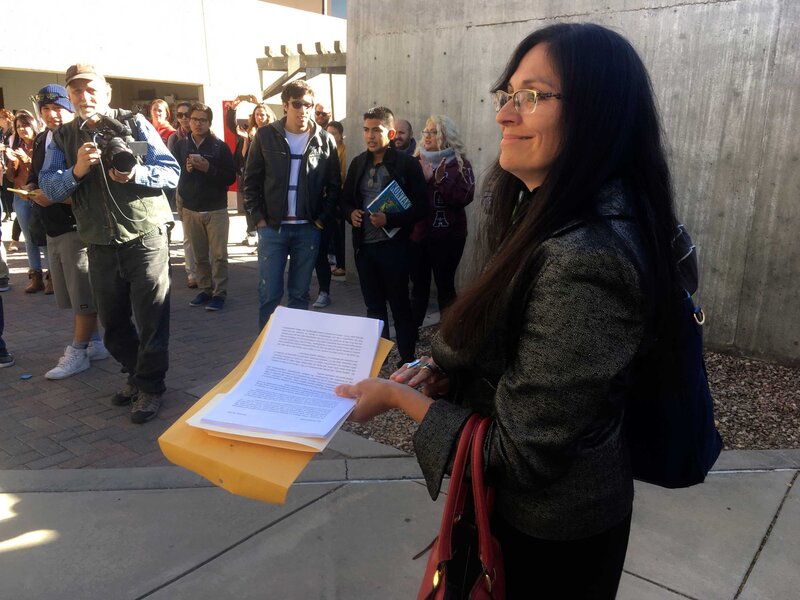What universities are doing to protect their undocumented students
Until the early hours of Nov. 9, Sylvia Gomez felt like she was finally getting ahead.
Now a junior at John Jay College of Criminal Justice in New York City, Ms. Gomez, an undocumented student from Lima, Peru, who was brought to the United States by her parents at age 11, recalls how she spent years juggling multiple under-the-table jobs to pay for college while struggling to keep her grades up.
Overwhelmed, she dropped out in 2012.
But that year, President Obama signed an executive action, Deferred Action on Child Arrivals (DACA), which has since brought more than 700,000 eligible students like Gomez out of the shadows. In addition to offering temporary deportation relief, DACA allocates them a Social Security number, issues a work permit, and grants eligibility for a driver’s license.
DACA was a lifeline for Gomez’s college aspirations. She reenrolled, and before the election, was planning to go on a study abroad program in Quintana Roo, Mexico, this winter.
However, after Donald Trump’s win, she followed legal advice to withdraw from the abroad and began working more hours to save extra money. She was concerned Mr. Trump could follow through on his promise to “immediately terminate” DACA, and wanted to ensure she wasn’t stranded outside the country.
“He hasn't even taken office yet, but he's already creating this intense fear in the undocumented community,” says Gomez, who asked to use a pseudonym to protect her identity. “It's that we don't know what's going to happen next that scares us the most.”
More than 250 presidents of colleges and universities have signed a letter calling for U.S. leaders to continue DACA, calling it a "moral imperative and a national necessity." Meanwhile, faculties and administrators from coast to coast are striving for a balance between responding with urgency and avoiding unnecessarily stoking fear, as college students protest and petition their campuses to increase support for undocumented students.
“My greatest fear is that we will either frighten, or give false hope to these students,” says Michael Olivas, acting president of the University of Houston-Downtown and law professor. Stressing he was speaking solely in his capacity as a professor of immigration law for 35 years, he says, “I have yet to see what's going to happen, but I can't imagine that we would allow 700,000 [students] who haven't broken any law – that we will remove them. It makes no sense; it's counterintuitive in every way.”
Bipartisan history
Professor Olivas says while law enforcement officers are unlikely to begin deporting college students en masse, revoking DACA would mean America’s failure to capitalize on students it has educated from K-12, and whose youth and resilience would be integral to the nation’s prosperity.
Since President Reagan, the United States has a bipartisan history of embracing the education of undocumented students, according to Olivas. In 1982, the United States Supreme Court ruled in Plyler v. Doe that such students could neither be denied access to K-12 education, nor charged for it. Mr. Obama signed DACA exactly 30 years later, expanding access to include higher education.
But some, mostly in red states, see Trump’s promise to revoke DACA as a good thing. They don’t buy the argument that undocumented students should be allowed protected status and access to college simply because they were brought involuntarily to this country.
Universities across the country have urged any undocumented students studying abroad to come back before the Jan. 20 inauguration, so that they aren’t stranded if DACA is revoked. Since the election, students and faculty at more than two dozen public and private colleges have petitioned administrators to declare “sanctuary campuses.”
Call for 'sanctuary campuses'
Last week, Rutgers’ president, responding swiftly to a student petition, said the New Jersey university would protect the privacy of its undocumented members. On Tuesday, Columbia University in New York did the same, adding that the university would expand financial assistance to those students if DACA is revoked.
“The University will neither allow immigration officials on our campuses without a warrant, nor share information on the immigration status of undocumented students with those officials unless required by subpoena or court order, or authorized by a student,” Columbia Provost John Coatsworth said in an email to the university.
While not a legal term, so-called “sanctuary cities” are those where a locally passed mandate prohibits law enforcement from cooperating with immigration officials in certain circumstances. How that would translate to a college campus is unclear, legal scholars say. In practice, it might involve unwillingness to share student information unless subpoenaed or to welcome law-enforcement officials seeking undocumented students on campus. While a 2011 US Immigration and Customs Enforcement (ICE) policy memo generally instructs ICE officers not to raid “sensitive locations” including colleges, some experts speculate this policy may change under a Trump administration.
“I think it’s a symbolic effort that will make undocumented students feel more secure on campuses that adopt this,” Stephen Yale-Loehr, a professor of immigration law practice at Cornell University Law School, told Inside Higher Ed. “I’m not sure, however, that such sanctuary resolutions carry much legal weight. I think it will make campus administrators more hesitant to contact immigration officials, but if immigration officials say, ‘We’re looking for a specific student,’ I’m not sure that a sanctuary resolution will necessarily bar the campus from cooperating if they have to…. [A]t the end of the day an immigration official can always get a warrant if necessary.”
Not giving up
At the City University of New York’s (CUNY) John Jay College of Criminal Justice that Gomez attends, Isabel Martinez works closely with DACA students who she says are visibly shaken.
“Students are not eating, can't sleep, and are totally distracted,” she says. “I've seen students who days after the election looked a lot paler and thinner.”
CUNY estimates it taught around 6,000 undocumented and DACA students across its sprawling city campuses in 2015. John Jay alone estimates it has 1,300. To embrace this cohort, Professor Martinez, director of the Unaccompanied Latin American Minor Project at John Jay, rattles off a slew of university-wide efforts aimed at helping them stay calm and build solidarity, but also preparing students and families for possible deportation.
She has recruited one of her former students, an Immigrant Justice Corps fellow, to screen undocumented and DACA students to see if they are eligible for any other types of financial relief – even with DACA, undocumented students are ineligible for federal loans or Pell Grants. Another marquee event is a resource fair for students and their families to learn about their legal rights and available social services.
Despite the uncertainty, Gomez says a desire to one day earn enough that her father can stop working, along with concern about her parents’ and sister’s safety, drives her to succeed.
“I don't know what's going to happen in January, and you know, to be honest I haven't saved a lot of money, but I refuse to drop out of school next year, whether I have DACA or not.”






